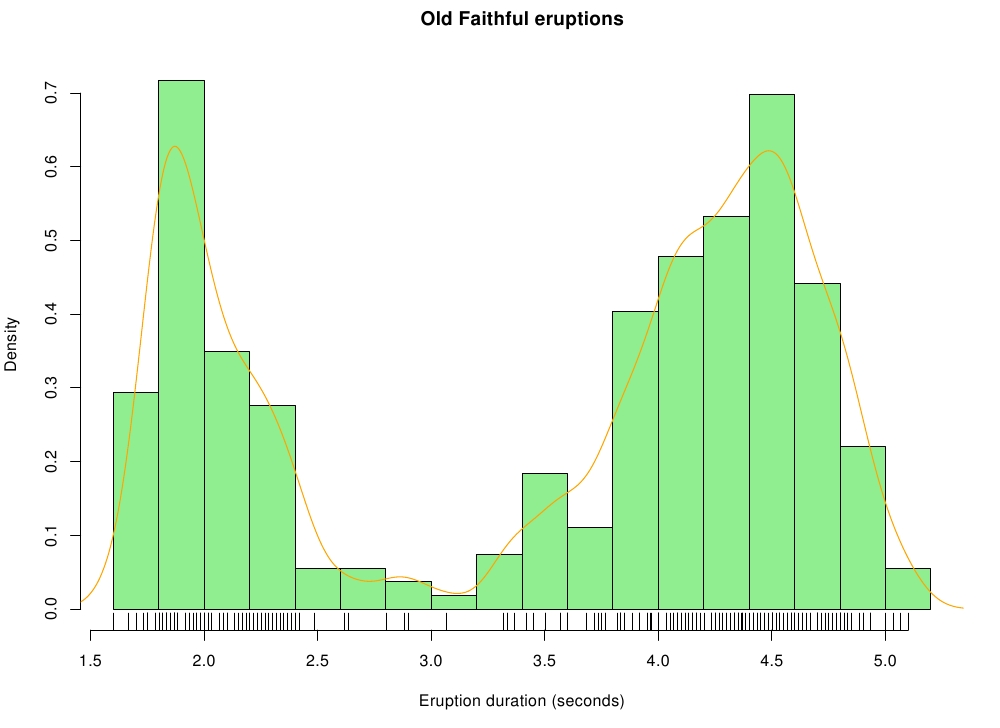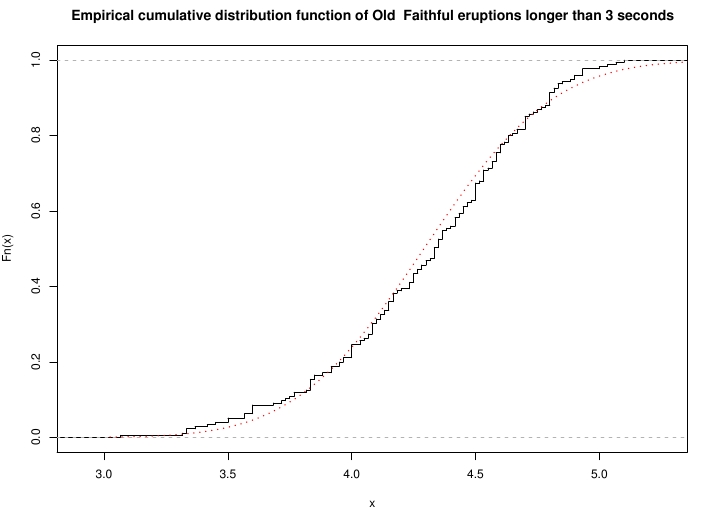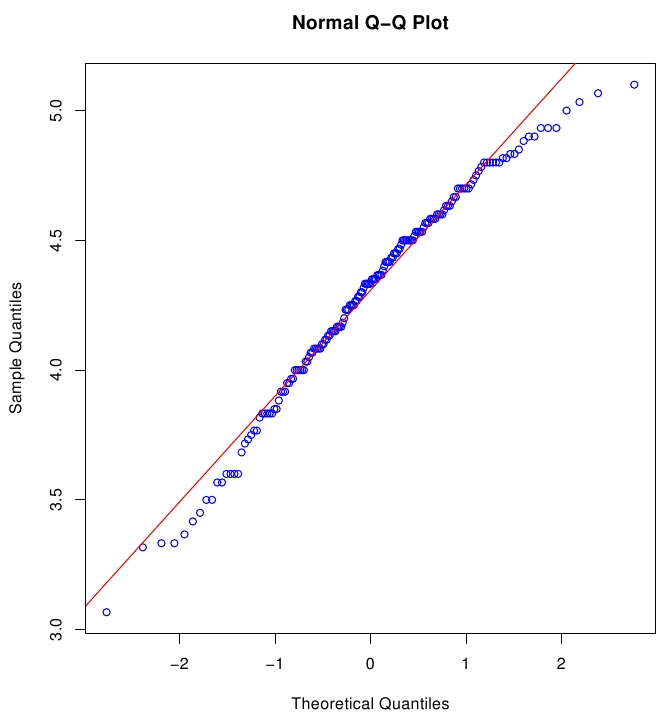| require "rinruby" |
faithful_data = {"eruption_duration"=>[], "waiting_time"=>[]} |
for row in File.readlines('faithful.dat')[1..-1]
splitrow = row.chomp.split
faithful_data["eruption_duration"] << splitrow[0].to_f
faithful_data["waiting_time"] << splitrow[1].to_i
end |
R.ed = faithful_data["eruption_duration"]
R.eval "edsummary <- summary(ed)"
edsummary = R.pull("as.vector(edsummary)")
keys = R.pull("names(edsummary)")
puts "Summary of Old Faithful eruption duration data"
keys.each_index do |i|
puts "#{keys[i]}: #{sprintf('%.3f',edsummary[i])}"
end
puts
puts "Stem-and-leaf plot of Old Faithful eruption duration data"
R.eval "stem(ed)" |
R.eval <<EOF
png("faithful_histogram.png",width=10,height=7.5)
hist(ed,seq(1.6, 5.2, 0.2), prob=1,col="lightgreen",
main="Old Faithful eruptions",xlab="Eruption duration (seconds)")
lines(density(ed,bw=0.1),col="orange")
rug(ed)
dev.off()
EOF |
cutoff = 3
R.long_ed = R.ed.delete_if{ |x| x <= cutoff }
R.eval <<EOF
png('faithful_ecdf.png',width=10,height=7.5)
# library(stepfun) # package has been merged into 'stats'
plot(ecdf(long_ed), do.points=0, verticals=1,
main=paste('Empirical cumulative distribution function of Old',
' Faithful eruptions longer than #{cutoff} seconds'))
x <- seq(3,5.4,0.01)
lines(seq(3,5.4,0.01),pnorm(seq(3,5.4,0.01),mean=mean(long_ed),
sd=sqrt(var(long_ed))), lty=3, lwd=2, col='red')
dev.off() |
png('faithful_qq.png',width=10,height=7.5)
par(pty="s")
qqnorm(long_ed,col="blue")
qqline(long_ed,col="red")
dev.off()
EOF |
# R.eval "library('ctest')" # package has been merged into 'stats'
puts
puts "Shapiro-Wilks normality test of Old Faithful eruptions" +
" longer than #{cutoff} seconds"
R.eval "sw <- shapiro.test(long_ed)"
puts "W = #{sprintf("%.4f",R.pull("sw$statistic"))}"
puts "p-value = #{sprintf("%.5f",R.pull("sw$p.value"))}" |
puts
puts "One-sample Kolmogorov-Smirnov test of Old Faithful eruptions" +
" longer than #{cutoff} seconds"
R.eval "ks <- ks.test(long_ed,'pnorm',mean=mean(long_ed),"+
"sd=sqrt(var(long_ed)))"
puts "D = #{sprintf("%.4f",R.pull("ks$statistic"))}"
puts "p-value = #{sprintf("%.4f",R.pull("ks$p.value"))}"
puts "Alternative hypothesis: #{R.pull("ks$alternative")}"
puts |
| from rpy import *
|
faithful_data = {"eruption_duration":[],
"waiting_time":[]} |
f = open('faithful.dat','r')
for row in f.readlines()[1:]: # skip the column header line
splitrow = row[:-1].split(" ")
faithful_data["eruption_duration"].append(float(splitrow[0]))
faithful_data["waiting_time"].append(int(splitrow[1]))
f.close() |
ed = faithful_data["eruption_duration"]
edsummary = r.summary(ed)
print "Summary of Old Faithful eruption duration data"
for k in edsummary.keys():
print k + ": %.3f" % edsummary[k]
print
print "Stem-and-leaf plot of Old Faithful eruption duration data"
print r.stem(ed) |
r.png('faithful_histogram.png',width=733,height=550)
r.hist(ed,r.seq(1.6, 5.2, 0.2), prob=1,col="lightgreen",
main="Old Faithful eruptions",xlab="Eruption duration (seconds)")
r.lines(r.density(ed,bw=0.1),col="orange")
r.rug(ed)
r.dev_off() |
long_ed = filter(lambda x: x > 3, ed)
r.png('faithful_ecdf.png',width=733,height=550)
r.library('stepfun')
r.plot(r.ecdf(long_ed), do_points=0, verticals=1, col="blue",
main=paste("Empirical cumulative distribution function",
" of Old Faithful eruptions longer than 3 seconds")
x = r.seq(3,5.4,0.01)
r.lines(r.seq(3,5.4,0.01),r.pnorm(r.seq(3,5.4,0.01),mean=r.mean(long_ed),
sd=r.sqrt(r.var(long_ed))), lty=3, lwd=2, col="red")
r.dev_off() |
r.png('faithful_qq.png',width=733,height=550)
r.par(pty="s")
r.qqnorm(long_ed,col="blue")
r.qqline(long_ed,col="red")
r.dev_off() |
r.library('ctest')
print
print("Shapiro-Wilks normality test of Old Faithful eruptions" +\
" longer than 3 seconds")
sw = r.shapiro_test(long_ed)
print "W = %.4f" % sw['statistic']['W']
print "p-value = %.5f" % sw['p.value'] |
print
print("One-sample Kolmogorov-Smirnov test of Old Faithful eruptions" +\
" longer than 3 seconds"
ks = r.ks_test(long_ed,"pnorm", mean=r.mean(long_ed),
sd=r.sqrt(r.var(long_ed)))
print "D = %.4f" % ks['statistic']['D']
print "p-value = %.4f" % ks['p.value']
print "Alternative hypothesis: %s" % ks['alternative']
print |
|



